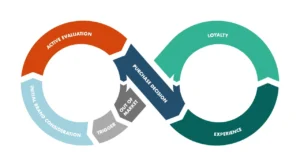In 2025, the digital marketing landscape is undergoing a significant transformation as third-party cookies, once a cornerstone of targeted advertising, begin to fade. This shift is driven by growing concerns over digital privacy and regulatory pressures, compelling marketers to rethink their data strategies and adapt to a cookie-less future. As Google Chrome, the most widely used browser, adjusts its approach to third-party cookies, marketers face both challenges and opportunities in this new era.
Introduction: Understanding the Shift
The end of third-party cookies signals a fundamental change in how digital marketers collect data, target audiences, and measure campaign success. With browsers like Safari and Firefox already blocking third-party cookies, Google Chrome’s decision to maintain a user-choice model for cookies reflects ongoing industry negotiations and regulatory oversight. This shift towards a privacy-first internet requires marketers to focus on first-party data and alternative targeting methods to maintain effective marketing strategies.
Background: The Evolution and Decline of Third-Party Cookies
Third-party cookies have been instrumental in programmatic advertising and personalized marketing for over a decade. However, rising concerns around data privacy, exemplified by regulations like GDPR and CCPA, and consumer demand for control over personal data have accelerated their decline.
Browser Movements: Safari introduced Intelligent Tracking Prevention (ITP) in 2017, followed by Firefox’s Enhanced Tracking Protection (ETP) in 2019, which blocked third-party cookies by default.
Google’s Timeline: Initially announced in 2020 to phase out third-party cookies by 2022, Google repeatedly postponed the deadline until early 2025. However, as of April 2025, Chrome has shifted to a user-choice model, allowing users to decide whether to block cookies.
Latest Features, Tools, and Trends in a Cookie-Less Future
To replace third-party cookies, industry players are developing privacy-centric technologies:
- Privacy Sandbox APIs: These include Federated Learning of Cohorts (FLoC) and Topics API, designed to enable interest-based advertising without revealing individual user identities.
- First-Party and Zero-Party Data: Marketers are focusing on collecting data directly from customers through owned channels and explicit user inputs (zero-party data) to build accurate audience profiles.
- Contextual Advertising: Targeting based on the content of web pages rather than user behavior is gaining traction as a privacy-friendly alternative.
- AI-Powered Analytics: Artificial intelligence helps interpret complex datasets from multiple sources to deliver personalized experiences without invasive tracking.
Advanced Tactics for Success in the New Marketing Landscape
Marketers need to adopt innovative approaches to thrive post-third-party cookies:
- Leverage First-Party Data: Invest in CRM systems, loyalty programs, and direct customer interactions to gather rich data.
- Utilize AI and Machine Learning: Use AI tools to analyze first-party and zero-party data for predictive insights and personalized campaigns.
- Explore Alternative Identifiers: Solutions like Unified ID 2.0 and authenticated traffic solutions offer privacy-compliant targeting.
- Enhance Contextual Targeting: Align ads with relevant content themes and demographics without relying on cookies.
- Implement Consent Management Platforms (CMPs): Ensure compliance with privacy laws and build customer trust through transparent data practices.
Amquest Education’s Digital Marketing and Artificial Intelligence course offers detailed modules on these advanced tactics, blending theoretical knowledge with practical AI applications in marketing. The course includes hands-on projects and internships, making it an ideal pathway for marketers to gain practical expertise in this evolving domain.
The Power of Content, Storytelling, and Community in a Privacy-First Era
With reduced access to granular tracking, marketers must deepen engagement through compelling content and community building:
- Storytelling: Craft narratives that resonate emotionally and foster brand loyalty.
- Community Engagement: Build brand communities that encourage interaction and co-creation.
- User-Generated Content (UGC): Leverage authentic customer voices to enhance credibility and reach.
These strategies complement data-driven approaches by creating meaningful connections that transcend the limitations imposed by cookie deprecation.
Measuring Success: Analytics and Insights Without Third-Party Cookies
Measurement remains critical but requires new frameworks:
- Attribution Modeling: Shift to multi-touch attribution using first-party data.
- Aggregated Reporting: Use privacy-safe aggregated metrics provided by Privacy Sandbox APIs.
- AI-Driven Insights: Employ AI to detect patterns and optimize campaigns from available data.
- Experimentation and A/B Testing: Continually test strategies in a cookieless environment to refine approaches.
Amquest’s course emphasizes these analytical skills, equipping learners with tools and frameworks to accurately measure and optimize marketing performance in a privacy-conscious world.
Business Case Study: The New York Times’ Cookieless Journey
The New York Times, a leading global media company, faced challenges as third-party cookies waned, threatening its digital advertising revenue.
Challenges: Maintaining personalized advertising and subscription growth without invasive tracking.
Tactics Used:
- Expanded first-party data collection through subscription models and user registrations.
- Invested in contextual advertising partnerships.
- Integrated AI tools for audience segmentation and content personalization.
- Developed a consent-first approach aligning with privacy regulations.
Measured Results: The Times reported a 30% increase in subscription revenue and a 15% improvement in ad engagement metrics while maintaining compliance and user trust. This case exemplifies how marketers can successfully pivot by embracing first-party data and AI-driven cookieless marketing strategies.
Actionable Tips for Marketers Navigating the End of Third-Party Cookies Marketing
Here are actionable tips for marketers adapting to the new landscape:
- Audit Your Current Data Strategy: Identify gaps in first-party data collection and privacy compliance.
- Invest in AI-Powered Marketing Tools: Automate data analysis and campaign personalization.
- Prioritize Privacy and Transparency: Use CMPs and clear communication to build user trust.
- Experiment with Contextual and Consented Data: Diversify targeting methods beyond cookies.
- Train Your Team on Emerging Technologies: Stay updated with courses like Amquest Education’s Digital Marketing and Artificial Intelligence program.
- Leverage Internships and Industry Partnerships: Gain hands-on experience with real-world projects to understand evolving marketing dynamics.
Why Choose Amquest Education for Mastering the Cookie-Less Future?
Amquest Education, with its national online availability, stands out for its comprehensive Digital Marketing and Artificial Intelligence course that addresses the challenges of the end of third-party cookies marketing head-on. The course blends theoretical knowledge with practical AI applications, industry-experienced faculty, and comprehensive coverage of cookieless marketing strategies, preparing students for real-world challenges in a privacy-first digital ecosystem.
Conclusion
The end of third-party cookies marketing is reshaping how marketers approach customer tracking changes, targeted advertising, and data privacy in marketing. Success in this new era demands embracing first-party data, AI-driven insights, and privacy-first strategies. Marketers ready to adapt will find invaluable support through specialized education, which offers the knowledge, tools, and industry connections needed to thrive.
FAQs
Q1: How will the cookie-less future impact targeted advertising?
The cookie-less future limits traditional cross-site tracking, pushing marketers to rely more on first-party data, contextual targeting, and privacy-focused technologies like Google’s Privacy Sandbox to deliver relevant ads without compromising user privacy.
Q2: What are the main customer tracking changes marketers should expect?
Marketers will see a shift from third-party cookies to first-party and zero-party data collection, increased use of AI for data analysis, and more emphasis on user consent and transparency in data use.
Q3: How does data privacy in marketing influence the end of third-party cookies?
Data privacy laws and consumer demand for control over personal information have driven browsers and companies to phase out third-party cookies, promoting privacy-first marketing approaches that respect user rights.
Q4: Can first-party data replace third-party cookies effectively?
Yes, first-party data, collected directly from customers, is more reliable and privacy-compliant. Combined with AI analytics and contextual targeting, it can effectively replace many functions of third-party cookies.
Q5: What alternatives to third-party cookies exist for audience targeting?
Alternatives include Google’s Privacy Sandbox APIs, contextual advertising, authenticated traffic solutions like Unified ID 2.0, and increased reliance on zero-party data obtained through direct user engagement.










